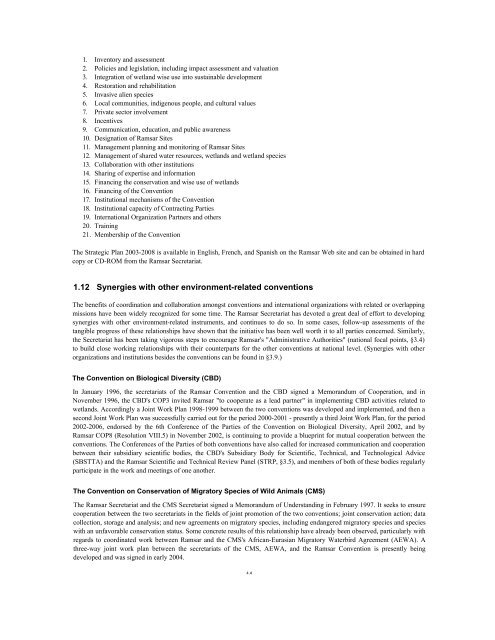The Ramsar Convention Manual.pdf
The Ramsar Convention Manual.pdf
The Ramsar Convention Manual.pdf
You also want an ePaper? Increase the reach of your titles
YUMPU automatically turns print PDFs into web optimized ePapers that Google loves.
1. Inventory and assessment<br />
2. Policies and legislation, including impact assessment and valuation<br />
3. Integration of wetland wise use into sustainable development<br />
4. Restoration and rehabilitation<br />
5. Invasive alien species<br />
6. Local communities, indigenous people, and cultural values<br />
7. Private sector involvement<br />
8. Incentives<br />
9. Communication, education, and public awareness<br />
10. Designation of <strong>Ramsar</strong> Sites<br />
11. Management planning and monitoring of <strong>Ramsar</strong> Sites<br />
12. Management of shared water resources, wetlands and wetland species<br />
13. Collaboration with other institutions<br />
14. Sharing of expertise and information<br />
15. Financing the conservation and wise use of wetlands<br />
16. Financing of the <strong>Convention</strong><br />
17. Institutional mechanisms of the <strong>Convention</strong><br />
18. Institutional capacity of Contracting Parties<br />
19. International Organization Partners and others<br />
20. Training<br />
21. Membership of the <strong>Convention</strong><br />
<strong>The</strong> Strategic Plan 2003-2008 is available in English, French, and Spanish on the <strong>Ramsar</strong> Web site and can be obtained in hard<br />
copy or CD-ROM from the <strong>Ramsar</strong> Secretariat.<br />
1.12 Synergies with other environment-related conventions<br />
<strong>The</strong> benefits of coordination and collaboration amongst conventions and international organizations with related or overlapping<br />
missions have been widely recognized for some time. <strong>The</strong> <strong>Ramsar</strong> Secretariat has devoted a great deal of effort to developing<br />
synergies with other environment-related instruments, and continues to do so. In some cases, follow-up assessments of the<br />
tangible progress of these relationships have shown that the initiative has been well worth it to all parties concerned. Similarly,<br />
the Secretariat has been taking vigorous steps to encourage <strong>Ramsar</strong>'s "Administrative Authorities" (national focal points, §3.4)<br />
to build close working relationships with their counterparts for the other conventions at national level. (Synergies with other<br />
organizations and institutions besides the conventions can be found in §3.9.)<br />
<strong>The</strong> <strong>Convention</strong> on Biological Diversity (CBD)<br />
In January 1996, the secretariats of the <strong>Ramsar</strong> <strong>Convention</strong> and the CBD signed a Memorandum of Cooperation, and in<br />
November 1996, the CBD's COP3 invited <strong>Ramsar</strong> "to cooperate as a lead partner" in implementing CBD activities related to<br />
wetlands. Accordingly a Joint Work Plan 1998-1999 between the two conventions was developed and implemented, and then a<br />
second Joint Work Plan was successfully carried out for the period 2000-2001 - presently a third Joint Work Plan, for the period<br />
2002-2006, endorsed by the 6th Conference of the Parties of the <strong>Convention</strong> on Biological Diversity, April 2002, and by<br />
<strong>Ramsar</strong> COP8 (Resolution VIII.5) in November 2002, is continuing to provide a blueprint for mutual cooperation between the<br />
conventions. <strong>The</strong> Conferences of the Parties of both conventions have also called for increased communication and cooperation<br />
between their subsidiary scientific bodies, the CBD's Subsidiary Body for Scientific, Technical, and Technological Advice<br />
(SBSTTA) and the <strong>Ramsar</strong> Scientific and Technical Review Panel (STRP, §3.5), and members of both of these bodies regularly<br />
participate in the work and meetings of one another.<br />
<strong>The</strong> <strong>Convention</strong> on Conservation of Migratory Species of Wild Animals (CMS)<br />
<strong>The</strong> <strong>Ramsar</strong> Secretariat and the CMS Secretariat signed a Memorandum of Understanding in February 1997. It seeks to ensure<br />
cooperation between the two secretariats in the fields of joint promotion of the two conventions; joint conservation action; data<br />
collection, storage and analysis; and new agreements on migratory species, including endangered migratory species and species<br />
with an unfavorable conservation status. Some concrete results of this relationship have already been observed, particularly with<br />
regards to coordinated work between <strong>Ramsar</strong> and the CMS's African-Eurasian Migratory Waterbird Agreement (AEWA). A<br />
three-way joint work plan between the secretariats of the CMS, AEWA, and the <strong>Ramsar</strong> <strong>Convention</strong> is presently being<br />
developed and was signed in early 2004.<br />
4 A












